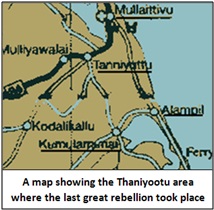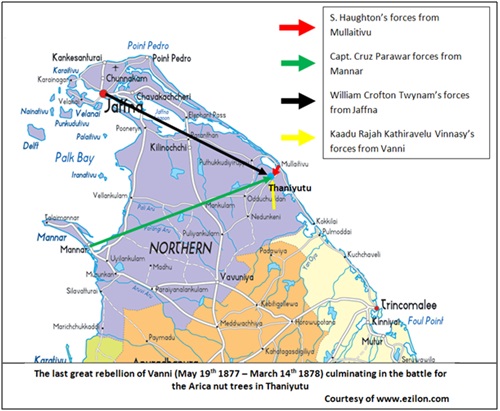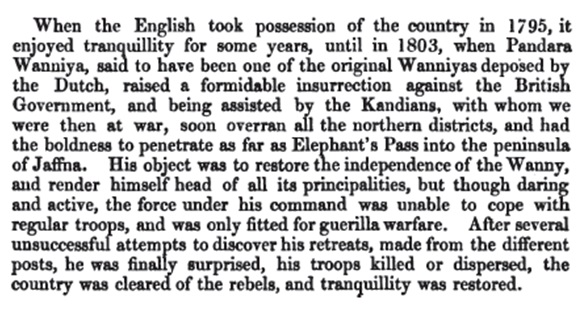by V P Lingajothy, Esq., August 25, 2013
Three different groups of Tamil forces led by three different Vanni chieftains converged on the Mullaitivu fort this day 210 years ago with their forces. Their intention was to liberate Vanni by starting from Mullaitivu which was its heart land (Ithayaboomi in Tamil). The ferocity of the attack by the combined Tamil forces was such that the British soldiers and their allied forces holding the fort, although they put up a resistance, were unable to hold for long but were forced to flee. The Mullaitivu fort and the town fell to the Tamil forces before enemy reinforcements arrived from Jaffna, Trincomalee and Mannar. The fort was taken by the Tamil forces that secured it and hoisted the Tamil flag of Pandara Vanniyar and his allied forces led by Pariyari Vellar and the Dissava of Nuwarakalawiya Kumarasinga Vanniyan.
The grand design of Pandara Vanniyan and the contemporary rulers of Vanni including Pariyari Velar (chieftain from Karikkaddumulai whose real name was Kathirvelan) and Kumarasinga Vannian of Nuwarakalawiya (Maha Vanni) did not succeed, unfortunately, as their subsequent troop movements and hideouts were betrayed by a traitor — in this case Kadirgamanayaga Mudaliar of Melpattu East — to the British, alerting them to the impending peril at the hands of the Vanni forces in September 1810.
The intelligence information passed on by the said Kadirgamanayaga Mudaliar alerted Mr. Turnour, the collector of Vanni who prepared the British forces to face the Tamil forces from Vanni and eventually, as history has repeated itself now, the more superior international forces (the British also assisted by the Dutch and Malay mercenaries) defeated the valiant Tamil forces. Pandara Vanniyan was initially defeated at 5am on the 31st of October 1803, however, how the British forces found out about his whereabouts on this occasion is unknown, the historic records simply state that he was surprised by the early morning attack and that the British forces with their Dutch allies and mercenaries converged on Kachchilamadu from Jaffna, Trincomalee and Mannar and took on Pandara Vanniyan’s forces. Although his power was greatly reduced following this defeat, due to treachery, he later relied on the more ferocious warrior chieftain Pariyari Velar from Karikkaddumulai to expel the British from Vanni. Please refer to JPLM page 22 footnotes. The maps depicting the 2 attacks mentioned above are shown here.


Describing the attack on the Mullaitivu fort, Charles Pridham’s ‘An Historical, Political and Statistical Account of Ceylon and its Dependencies,’ Vol. 2, page 522 published in 1849, London states thus:
Another account of the fall of the Mullaitivu to the Tamil forces is given by J.P. Lewis in his ‘Manual of the Vanni Districts’, page 18, ‘’With the assistance of a body of Kandyans under the Disava of Nuwarakalawiya he overran the Vanni, and on August 25, 1803, attacked the government house at Mullaittivu in great force, drove out the garrison which was under the command of Captain Drieberg of the ‘’Invalid Malays,’’ and seized the Fort. Captain Drieberg withdrew his small garrison in good order to boats, which had been sent to Mullaittivu to secure his retreat and by this means to Jaffna’’.
Talking about this attack on Mullaitivu, the ‘Manual of the North Central Province’ by R. E. Ivers, 1899 edition, page 48 states the following: ‘’the Kandyans attacked all the British maritime territory from Hambantota to Mullaitivu. The Dissava of Nuwarakalawiya, with Pandara Vanniyar and the people of the Jaffna Vanni, attacked the latter fort. Lieutenant Drieberg, who was in command, abandoned it and retreated by sea to Jaffna, the Kandyans carried off some of the cannon, one of which now lies at Sinhaya Ultpota in Kunjuttu Korale’’. [emphasis added]
Historic records describe that Pandara Vanniyan was assisted by the Dissava of Nuwarakalawiya and the people of the Jaffna Vanni. Further research confirms that the Dissava of Nuwarakalawiya is a reference to Pandara Vanniyan’s brother-in-law (sister’s husband), Kumarasinga Vanniyan, eldest son of Nuwara Vanniya from Bulankulam (Vilankulam in Tamil) also known as Bulankulam Mudiyanse. One must note that the people in the Maha Vanni (Nuwarakalawiya and Thamankaduva) were Tamil speaking until the end of the 18th century. Please refer to pages 29 and 19 respectively of C.S. Navaratnam’s 1960 ‘Vanni and the Vanniyas’. However, at the beginning of the 19th century, some elements of Sinhalisation began to manifest, as can be seen from the names, i.e. Bulankulam Vanniya, Tamarawewa Vanniya (previously Tamarai Kulam Vanniyan) and Kumarasinga Kanea Wanniya. The population of Maha Vanni was Tamil blooded. Due to the Kandyan influence to the south of their territory, however, there was some peaceful Sinhala penetration at that time by inter-marriages. I am therefore correct to say that the forces from Nuwarakalawiya at the time of the attack on Mullaitivu were Tamil and also Tamil speaking, as otherwise they could not have interacted with the other allied Tamil forces from the Northern Vanni.
According to the available information and historic records, the reference ‘the people of the Jaffna Vanni’, is a reference to the people of the Mullaitivu District primarily from Kanukkerny, Thaniyutu and Mamulai (J.P. Lewis’s ‘Manual of Vanni’, herein after referred to as JPLM, page 58). In sharp contrast to the description of an attack in November 1810 into Kilakkumulai South where according to JPLM page 22, which I quote: ‘’the party (the forces of Pandara Vanniyan) was described as consisting of eight Malays, but it appeared to have been led by Pandara himself’’, the attack on Mullaitivu described as stated above by Mr. R.E. Ivers, states that the forces that attacked the Mullaitivu fort on the 25th of August 1803 were led by the Dissava of Nuwarakalawiya with Pandara Vanniyan and the people of the Jaffna Vanni.
It therefore becomes abundantly clear that the entire force on this attack was not led by Pandara himself but by him and 2 other chieftains. The anecdotal evidence and the information below, will confirm that the other forces (the people of the Jaffna Vanni) were led by a Vellalar chieftain from that area known as Pariyari Velar who is originally from the village of Kanukkerny. JPLM confirms that Pariyari Velar escaped from the Mullaitivu jail as he was held to face trial for murder in June 1807 and joined Pandara Vanniyan’s forces in 1809. The intelligence information as described in JPLM at pages 21 and 22 and other information at pages 18, 19, 239 and 319 confirms that Pariyari Velar, who was a chieftain, was held as a prisoner by the British but escaped and joined his forces who also assisted Pandara Vanniyan in his endeavors to overthrow the British in the areas under his control (Karikkaddumulai). From the available information, Pariyari Velar would have been only in his early teens in 1803. It therefore stands to reason that his father and his relatives, the most famous being the members of the Theerar clan, would have taken part in the attack on the Mullaitivu fort. Therefore, as stated previously, Pariyari Velar and his retinue would have been known as ‘the people of the Jaffna Vanni’. According to the information contained in some ola leaves in the possession of the famous Kailayapillai Vaithiyar (native physician in Tamil) and the astrologer Ramalingam, both from the Kanukkerny village in Vanni, Pariyari Velar’s forefathers were active from the early part of the 18th century (circa 1720) as Vanni chieftains primarily upholding the worship of Lord Muruga, Lord Ganesh and Lord Shiva in the saivite tradition who fiercely opposed the religious conversion of Hindus to Christianity. Furthermore, available evidence states that the hereditary chieftainship that they held was also passed down by the male line like any other member of Tamil Royalty.
I feel it appropriate to briefly say a few words about the Theerar clan. Theerar Kanapathay Pillai was known to have been the military commander of the Vanni kingdom circa 1634 when an incursion from the Kandyan kingdom took place into the Vanni territory, as Mr. Kanapathay Pillai — being the military commander (Senathypathy in Tamil) — led the Tamil cavalry and pushed the Kandyan troops back to the Vanni kingdom’s border with the Kandyan kingdom. History by word of mouth has it that although his forces were reduced to 50 men, Kanapathay Pillai was able to expel the Kandyan intruders from the Vanni kingdom following which he was given the honorary title of ‘Theerar’ (‘Theerar’ means a brave soldier or general in Tamil, this is an accolade bestowed on a military leader for extra-ordinary achievements of gallantry or bravery by the Tamil kings) by the Vanni king. This title was thereafter handed down to the first male member of the Kanapathay Pillai family. Although they named the first male child of the family Kanapathay Pillai and Velupillai alternatively, the members of the family were collectively known as the Theerar clan and they are from the Kanukkerny village in Vanni and had matrimonial alliances with the Velar clan of the same area (Kanukkerny/Thaniyutu) to which Pariyari Velar belongs.
Unfortunately, contemporary historians have overlooked the great war of independence led by Pandara Vanniyan, Pariyari Velar and other Vanni chieftains from the Mullaitivu District primarily from the Kanukkerny/Thaniyutu area. Much has been written about the defeat of Pandara Vanniyan at Kachchilamadu on the 31st of October 1803 and a pseudo-historian from Mulliyawalai had falsely claimed in his novel of the same name that Pandara Vanniyan was in fact killed at Kachchilamadu, giving a defeatist mentality to the Tamil people of Vanni. Whereas, JPLM confirms at page 52 that the Vanni chief Pandara died at the Panankamam village and not at Kachchilamadu and not from the intelligence information given by the treacherous Mudaliyar in October 1810. Page 21 of JPLM shows at least that Pandara Vanniyan was alive in October 1810, so it stands to reason that he passed away some time thereafter and the anecdotal history confirms that he died in 1811 due to a knee injury sustained during the fight. Pandara Vanniyan was neither killed nor captured alive but eventually succumbed to his injuries that he received perhaps at the hands of the enemy.
Following his death, the British wrongly claimed referring to Pandara Vanniyan’s death which I quote from page 19 of JPLM ‘’the power of the Vanni chiefs was thus finally and effectually extinguished’’. Following Pandara Vanniyan’s death, he did nothave any issue to follow him, neither did he have any brothers to succeed him. The only descendant of his family, namely Ponar Vannichchiyar, although moved to live in Jaffna, her descendants lived in Kanukkerny in the Mullaitivu district and they intermarried amongst the peripheral members of the Velar and Theerar clans. Perhaps there was also an earlier marriage connections between the families of the chieftains from Kanukkerny such as Pariyari Velar and Pandara Vanniyan’s family which may have led to Pandara Vanniyan forming a close and trusting association with Pariyari Velar.
There are folk songs that confirm the flame of freedom of Vanni was not extinguished following the death of Pandara Vanniyan. The struggle was continued by his erstwhile comrade in arms and a contemporary ruler of Vanni, the great warrior chieftain Pariyari Velar and his descendants, particularly his son Pariyari Vinnayar also known as Kaadu Rajah Kathiravelu Vinnasy (whose real name was Kathiravelu Vinnasythamby). It appears from the historic evidence available, i.e. written records from ola leaves, folk songs and history handed down by word of mouth by elders that Pariyari Velar continued with his struggle to liberate Vanni from the clutches of the foreign rule from his hideouts. He lived in relative obscurity within the Padawiya Nuwarakalawiya border jungle (Karikkaddumulai south borders Nuwarakalawiya and Padawiya is situated just south of the border inside Maha Vanni known as Nuwarakalawiya). It is firmly believed that his son Vinnayar was born in that jungle area when his father Pariyari Velar was living there in obscurity, hence his alias Kaadu Rajah meaning ‘King of the Jungle’ in Tamil. Kaadu Rajah’s birth circa 1830 and his subsequent fight for independence culminating in the battle for the Areca nut trees in Thaniyutu have been sung as a folk song giving the details of the English rulers he fought against. These incidents in the folk song are known as the Kamugam Sanday Paadal (battle for the Areca nut trees), which confirm unequivocally that at least until the time of S. Haughton being the assistant agent of Mullaitivu, Kaadu Rajah continued to agitate for freedom for Vanni. JPLM confirms S. Haughton as being the assistant agent of Mullaitivu from May 19th 1877 to March 14th 1878. Haughton also was the assistant agent of Vavuniya and Mullaitivu (Vanni) from April 1st 1883 and October 20th 1883. It appears from the evidence in the folk song mentioned above that Kaadu Rajah was betrayed once again by the local rulers — the Udaiyars, Vidanayars, Mudaliyars etc. — and that his heroic struggle came to an end during Haughton’s first tenure of office between the 19th of May 1877 and March 14th 1878. Sadly despite the fierce resistance of Kaadu Rajah, the son of Pariyari Velar, the superior forces led by the British from three points i.e. Jaffna, Mannar and Mullaitivu and assisted by the traitors from within finally defeated the last Rajah of Vanni.


Although this was a heroic struggle, this information was suppressed by the colonial rulers and they failed to document the history properly. This heroic freedom struggle was sung as a folk song by the local people, however, and remained within the oral tradition until 1979 when it was for the first time put into print form. The above map shows the details of the Kamugam Sanday, which is in fact the last fight for independence of Vanni. It cannot escape ones attention the striking similarity between the troop movements of the British to capture Pandara Vanniyan at Kachchilamadu on the 31st of October 1803 and the British troop movements to quell the freedom struggle of Kaadu Rajah Kathirvel Vinnasy at Thaniyutu in 1878. Details of this last freedom fight in Vanni have been given in detail in the book namely ‘Adankkapattu (Vanni) Part III Native Chieftains’ which I co-authored with television journalist Mr. Aruna Selladurai. I am currently writing about this great struggle for independence in a book form as ‘The Last Great Rebellion of Vanni’.
At least as far as the records and anecdotal history go, there was no war of independence following Kaadu Rajah Vinnasythamby’s defeat anywhere in Vanni. According to the known history, Pariyari Velar was never captured alive but his son Kaadu Rajah Vinnayar was pardoned by the British authorities and he remained in obscurity following his defeat until his death. A century later his great-great-grandson took up arms and joined a liberation organisation which defeated the enemy and once again took over Mullaitivu in July 1996. The great-great-grandson of Kaadu Rajah was known by the nom de guerre ‘Major Curdles’ and was affectionately known as Kerdy to his fellow freedom fighters. The great martyr (Maveeran in Tamil) Mahalingam Thileepan, otherwise known as Major Curdles, is a cousin of the most illustrious freedom fighter Brigadier Theepan. Colonel Theepan (Velayuthapillai Baheerathakumar) was posthumously promoted as Brigadier and according to journalist DBS Jeyaraj; Theepan could still have become the first major general of the Tamil Tigers who fought his Waterloo at Ananthapuram on the 4th of April 2009. Theepan and his leader V. Pirabaharan’s sacrifices for the liberation of their people is unparalleled not only in Tamil history but also in the history of mankind. None of these martyrs were caught alive but died a heroic death in the battle front. History has once again repeated itself, the great freedom fighters have been once again betrayed. Not only were they betrayed but also due to the changing geo-politics, all the major powers of the world became strange bed fellows, assisted the Tamil enemies and helped to defeat the Tamil freedom fighters. Mullaitivu has once again fallen to the enemy. Let us hope and wait that history will repeat itself and we Tamils will once again become the masters of this territory known as Ithayaboomi. When once again Mullaitivu will fall to the Tamil forces, on this occasion we will hold on to it forever with the power of the almighty god.
By V.P. Lingajothy Esq.
(Great-great-great-grandson of Pariyari Velar and a direct descendant of Senathypathy Theerar and also the current hereditary great chieftain of the entire Vanni including Maha Vanni)

A well researched article.
A good historical record which portrays our ancestors courage and resilience to outside destructive forces still lives on in our present day ” True Vannians ” as i was fortunate to see on my resent visit to Mullaitivu .Its not just history but present but will change for the better with the knowledge of history and support from united ”Tamil Uravugal” around the world.